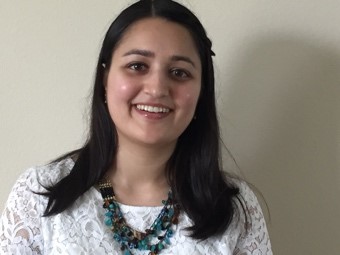Review: Assessing Stress During Wound Care in Real-Time Using Wearable Sensors
December 14, 2017
Temple University School of Podiatric Medicine Journal Review Club
Editor's note: This post is part of the Temple University School of Podiatric Medicine (TUSPM) journal review club blog series. In each blog post, a TUSPM student will review a journal article relevant to wound management and related topics and provide their evaluation of the clinical research therein.
Article title: Stressing the Dressing: Assessing Stress During Wound Care in Real-Time Using Wearable Sensors
Authors: Saman Parvaneh, Gurtej Singh Grewal, Ekta Grewal, Robert A. Menzies, Talal K. Talal, David G. Armstrong, Esther Sternberg, Bijan Najafi
Journal name and issue: Wound Medicine, February 2014
Reviewed by: Saakshi Chowdhary, Class of 2020, Temple University School of Podiatric Medicine
Introduction: The Stress Response in Wound Care in Diabetic Foot Ulcers
Within the last decade, the rise of diabetes in the U.S. population has been matched with a rise in diabetic foot ulcers requiring amputations. Because many of these diabetic foot ulcers develop secondary to poor wound healing and susceptibility to infection after surgery, some important risk factors have been evaluated. Stress, among other factors, has been shown not only to affect the psychological state of a patient, but also biologically to impair immunity and induce an inflammatory microenvironment within patients.
Although previous studies have measured stress by using heart rate and respiration rate during a dressing change lasting three to five minutes, no studies have continuously quantified stress in patients with diabetic foot ulcers during a routine visit. This particular study attempted to examine the stress response in patients with diabetic foot ulcers by using a chest-worn sensor displaying heart rate data. The research team relied on an algorithm to estimate stress that used changes in heart rate variability, a measurement that is taken between two consecutive R waves of an electrocardiogram.
Materials and Methods: Electrocardiographic Monitoring of Wound Dressing Changes in Diabetic Foot Ulcers
Twenty patients with diabetic foot ulcers were recruited from a wound care center and were given the BioHarness3, an FDA approved body device to evaluate single-channel electrocardiogram activity, respiration rate, posture, and core body temperature. To ensure quality control, the team used a smart phone to monitor data in a real-time fashion. This smart phone and BioHarness3 system had a biomodule that was linked to the patient’s body via a biopatch and electrocardiogram electrodes.
The electrocardiogram data were sampled at 250-Hertz frequency and gave an indication of heart rate variability. These data were all collected during routine patients’ visits for wound dressing changes. With the biopatch attached to the sternum of these patients, data were obtained for a span of 45 minutes, including the pre-dressing time for baseline reference data, the dressing time, and the post-dressing time. During the dressing, patients were seated from a waiting room chair to a special podiatric chair, and after the procedure ended, patients were asked to return to the waiting room chair and sit for another 15 minutes, during which their post-dressing heart rate data were collected. The sensor was removed after the 45-minute period.
After the study the recorded data were translated over to a computer with a newly customized algorithm that attempted to decipher the heart rate data from the electrocardiogram. Baseline wander is the deviation of the electrocardiogram baseline in response to patient or electrode movement, and because it can affect R-wave detection, it was an issue that needed to be corrected via a median filter. Automated code was meant to detect peaks corresponding to R waves and was revised to a manual function for any incorrect peak detections. After the distance between two R waves was measured, the heart rate variability was quantified as a standard deviation of R-R intervals in three-minute windows. The initial three-minute data window was interpreted as a low stress baseline heart rate variability value that had been taken during the waiting period. Any changes in heart rate variability were then compared with this baseline heart rate variability. When heart rate variability was in the 60% to 85% level, patient was identified as having medium level stress, and when values were above 85%, it was identified as low level stress. A value below 60% of the baseline HRV was considered a high stress response. The durations of high stress and medium stress were reported in percentages of total visit time.
Results
Data were obtained for 15 patients, excluding those patients with arrhythmias or with low quality signals. The average age of patients was 56.7 years, and 67% of them were male. The average duration of diabetes was 14.4 years, with 87% of participants having had previous foot ulcers.
On average, a low stress period in a participant comprised 28% of the total stress period, and a high stress period made up about 87% of the total stress period. For all participants, stress was at its maximum value during the dressing change or the meeting with the doctor. During the entire span of the visit, all patients experienced stress values ranging from 13% to 87%. The average medium stress was 28% of the time of the visit, and high stress was an average of 16% of the total time for all patients. A closer look at the data revealed that high stress periods occurred for 27% of the total time within the 60% of patients who experienced high stress periods.
The average duration of dressing change time was 11.5 minutes. During this time of wound dressing change, a medium level of stress was experienced for an average duration of 46.6% of the dressing time, whereas high stress episodes were experienced for an average duration of 18.3% of the time of wound dressing change for all patients. Medium stress duration was significantly higher, by an average of 66%, compared with the entire period of the clinic visit. Only 40% of patients experienced high stress periods during wound dressing time, with an average of 45.6% of the time. For about 27% of patients, high stress periods continued occurring in post–wound dressing time.
Discussion
Although previous studies have examined stress levels by using a limited time period of measuring physiological parameters, this study aimed to monitor stress further in a continuous way by using the pre-dressing, dressing, and post-dressing times during a routine visit. The study also attempted to use more specific means of measuring stress such as heart rate variability, as opposed to the salivary cortisol or blood pressure measures that previous studies used. The purpose of using a more minute parameter such as heart rate variability was to try to detect what caused the stress change at a given time and possibly use the data to enable better stress management in patients.
Overall, the results of the study were consistent with previous studies’ results in that patients were shown to experience higher levels of stress during the dressing period compared with the time before the dressing period. The stress results also seemed to increase when patients were meeting with doctors, possibly because of the psychological stress of meeting with a clinician to discuss health issues (also known as the white coat syndrome).
Even though the study did not consider factors such as psychological stress responses, hormonal responses, and the progress and stages of wound healing, it was a novel study that evaluated the stress levels of patients with diabetic foot ulcers. Given that diabetic neuropathy is often a prevalent condition in these patients, evaluating the causes and amounts of stress in this cohort of patients becomes even more interesting.
The results of this study demonstrated that the average total stress time in patients comprised 44% of the time of the total visit, and high stress was experienced in 40% of patients during the wound dressing period. Additionally, the study brought to light the interesting concept that patients experienced stress after wound dressing, and this is something that should be explored even further to evaluate what could be a potential stressor for patients. This could further help the scientific community and clinicians take steps to prevent, weaken, and eliminate stressors to better manage treatment and maintain health in patients with chronic diseases. Overall, the results of the study along with future studies could also be useful to mental health clinicians in determining how to provide for patients who are undergoing chronic disease management and strive to offer supportive therapy accordingly.
About The Author
Saakshi Chowdhary is a second year podiatric medical student at Temple University School of Podiatric Medicine (TUSPM) in Philadelphia, Pennsylvania. She is currently the President elect of the TUSPM Journal Club and the Events Coordinator for American Public Health Association. She graduated from the University of Texas at Austin in Austin, Texas with a Bachelor of Science in Nutritional Sciences. While in college, Saakshi was actively involved in public health and global health organizations that promoted medical mission trips and service projects targeting community health and well-being. Saakshi is interested in diabetic limb salvage, wound care, and reconstructive surgery and hopes to continue learning more about these topics through her involvement in the Journal Club.
Dr. James McGuire is the director of the Leonard S. Abrams Center for Advanced Wound Healing and an associate professor of the Department of Podiatric Medicine and Orthopedics at the Temple University School of Podiatric Medicine in Philadelphia.
The views and opinions expressed in this content are solely those of the contributor, and do not represent the views of WoundSource, HMP Global, its affiliates, or subsidiary companies.








